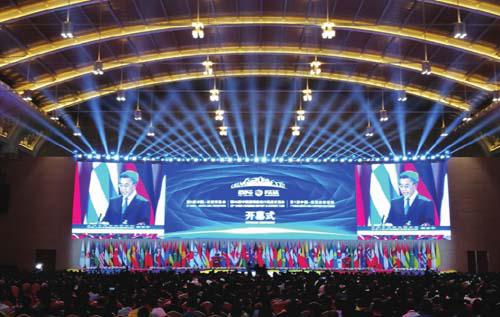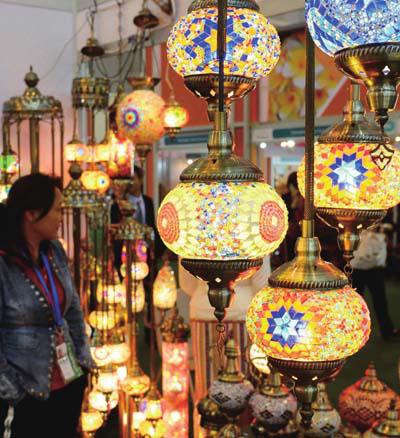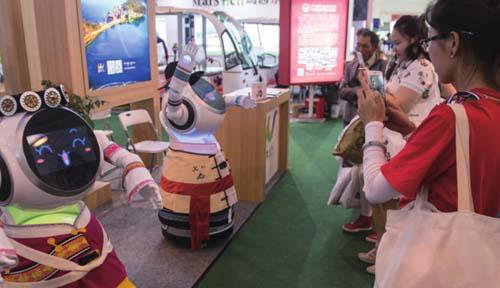Potential Unleashed
2018-07-16ByYuLintao
By Yu Lintao



It was the fourth time that Pakistani carpet trader Zaid Hamid was participating in the China-South Asia Expo (CSAEXPO) in Kunming, capital of southwest Chinas Yunnan Province, and he was satisfied with his products sales. “Pakistan has the worlds top-quality handmade carpet. Sales volume in one day here equates to more than one month in my country,” he told Beijing Review.
As a veteran CSAEXPO participant, Hamid explained how the expos host provides more and more preferential policies for foreign exhibitors such as concessions for booth rental and customized service, and so he has introduced his friends and relatives to join the event. Besides retail, Hamid is also planning to cooperate with Chinese agents to expand his business in China.
Sri Lankan jewelry merchant Mohamed Insaff, owner of jewelry company Golden Jewellers in Colombo, began attending exhibitions in Yunnan in 2011. He said he has never missed the opportunity to display and expand the popularity of his brand at the CSAEXPO.
Insaff told the Chinese media that more Chinese customers are taking an interest in South Asian jewelry. This year, he brought high-quality sapphires, tourmaline, rubies, tsavorite and garnets to the CSAEXPO for display and sale. Due to the increasingly interconnected economic relationship between China and South Asia, he is confi dent of the future of his business in China.
The CSAEXPO, launched in 2012 and cohosted by Chinas Ministry of Commerce and the Yunnan Provincial Government, dates back to the China Kunming Import & Export Fair which began in 1994. After more than 20 years of evolution, the event has gradually made a name for itself, drawing more and more domestic and overseas enterprises to participate, and developing into an important platform to promote economic and trade cooperation as well as people-topeople communication between China and its southern neighbors, said Gao Shuxun, Vice Governor of Yunnan and President of the organizing committee for this years Fifth CSAEXPO.
The expo is attended not only by traders from China and South Asian countries, but also business people from Southeast Asia as well as other parts of the world including Europe and Oceania. According to organizers, this years event, held from June 14 to 20, attracted 3,825 companies and organizations from 87 countries and regions. More than 42.46 percent of exhibitors are from abroad, with the participation of 12 of the worlds top 500 companies. Enterprises from Denmark, the Netherlands, Kyrgyzstan and Syria joined the event for the fi rst time.
Economic interaction
With a population of around 1.7 billion, South Asia is one of the most promising emerging markets in the world. Along with economic reforms and the gradual improvement of the investment environment within the countries in the subcontinent, it offers great business opportunities.
In recent years, economic and trade relations between China and South Asian countries have maintained sound momentum, with China the largest trading partner of most of the regions nations. According to statistics from Chinas Ministry of Commerce, in 2017 trade between China and South Asia reached $126.77 billion, an increase of 14.6 percent year on year. China is also one of the largest investors in South Asia. As of April, Chinese direct investment in the region had surpassed $11.84 billion.
The CSAEXPO contributes to this close economic and trade relationship between China and South Asia. For instance, during the Fourth CSAEXPO in 2016, international trade and cooperation deals worth around$6.5 billion (agreements of intention included) were signed, many of which were between China and South Asian countries. This year, the expo witnessed the signing of 251 contracts and cooperation deals as well as 205 agreements of intention, with a combined value of $12.4 billion, according to organizers.
Addressing the opening ceremony of this years CSAEXPO session, Haji Mohammad Mohaqiq, Deputy Chief Executive of Afghanistan, said the events most important goal is to strengthen cooperation between South Asian countries and East Asia in commerce, science, technology and economics. He believes that it can provide a unique opportunity for participating countries to expand their investment and trade not only in South Asia but in other parts of the world as well.
In his speech during the China-South Asia Cooperation Forum, a sub-activity of the CSAEXPO, Adam Thaufeeg, Deputy Minister of Economic Development of the Maldives, said the future of Asian countries is closely bound, and he hopes for all countries to carry out further cooperation across more fi elds in the future.
Pancha Ratna Shakya, Vice President of the Nepal-China Chamber of Commerce and Industry, told the audience at another subactivity that in the era of globalization, the interdependency of national economies has a vital role to play in the growth process. Via the CSAEXPO, a platform created by China,participating countries benefi t by promoting their products, and can express their views on development issues, she said.
This years CSAEXPO session has also assumed another important task: to improve the balance of trade between China and South Asian countries.
Huge potential needs to be further tapped in trade between both sides, said Zhang Wei, Vice President of the China Council for the Promotion of International Trade. Zhang said there is no shortage of competitive products coming from South Asian countries, but they are still unfamiliar to Chinese customers. Thus, promotional efforts should be further strengthened.
Li Jiming, Director of the Foreign Affairs Offi ce of the Yunnan Provincial Government, said at a press conference during the expo that one of the missions of this years CSAEXPO session was to help foreign products expand their market share in China and to let Chinese customers gain access to more high-quality commodities from South Asian countries. “We successfully attracted a more international crowd, with foreign exhib- itors accounting for more than 40 percent of the total,” said Li. “In a certain sense, this years CSAEXPO session can be also seen as a small-scale import fair.”
Common development
Despite relatively high speed growth in recent years, South Asia is still one of the most underdeveloped regions in the world with large populations still living in poverty. Achieving common development and sharing experience in poverty reduction thus became hot topics during a series of sub-activities at the CSAEXPO this year, including the 13th ChinaSouth Asia Business Forum, the Yunnan-South Asia and Southeast Asia Education Cooperation Forum, the First China-South Asia Cooperation Forum and the Third Yunnan Conference on International Exchange of Professionals.
Rowen Edirisinghe, President of the SAARC (South Asian Association for Regional Cooperation) Chamber of Commerce and Industry, claimed that South Asia has great potential for development with a vast market and can be a new growth driver for the world economy, but that a universal diffi culty faced by the region is weak infrastructure. Meanwhile, China has advanced technology and rich experience in infrastructure construction. He called on the two sides to complement each others advantages to strengthen interconnectivity and promote the social and economic development of all.
Ganesh Kumar Gupta, President of the Federation of Indian Export Organizations, shared a similar view to Edirisinghe, suggesting South Asian countries enhance interconnectivity with China and establish a differentiated industrial chain based on their respective advantages to further tap the regional market.
According to Shakya from Nepal, South Asian countries have strong interest in Chinas experiences of economic success. Meanwhile, they expect to learn from Chinas industry and trade promotion practices, get easy access to project financing from the Asian Infrastructure Investment Bank and increase opportunities to participate in projects under the Belt and Road cooperation framework with Chinas help.
Belt and Road role
South Asia is the confluence of the Silk Road Economic Belt and the 21st-Century Maritime Silk Road and thus the region has an important role to play in the implementation of the China-proposed Belt and Road Initiative. During discussions at various sub-forums of this years CSAEXPO session, great hope was placed on the initiative to boost regional development.
Bhawani Mishra Rana, President of the Federation of Nepalese Chambers of Commerce and Industry, said the Belt and Road Initiative has offered huge opportunities for the development of her country. Nepal hopes industrial investment under the framework of the initiative can help modernize the countrys infrastructure and thus improve Nepals investment environment, according to her.
Muhammad Iqbal Tabish, Secretary General of the Federation of Pakistan Chambers of Commerce and Industry, said the initiative calls for joint cooperation in industrial infrastructure construction to help upgrade industrial development. The ChinaPakistan Economic Corridor launched under the initiative has not only laid the foundation for his countrys industrial development, but can also benefit other countries in the region.
Afghanistans Mohaqiq pointed out that his country is one of the fi rst to have signed a joint agreement on the Belt and Road Initiative with China. The realization of this vision will connect Asias north and south via Afghanistan, transforming the country into a regional hub.
Gao Yan, Chinas Vice Minister of Commerce, said the Belt and Road Initiative has so far received the support of more than 100 countries and organizations including those in South Asia, and many early results have already been achieved under its framework in the region such as the BangladeshChina-India-Myanmar Economic Corridor and the China-Pakistan Free Trade Zone. China and Nepal are also in the process of constructing a cross-Himalaya railway project.
Along with the constant advancement of the Belt and Road Initiative, regional cooperation and economic development potential in South Asia will be further unleashed, Gao Yan said.
